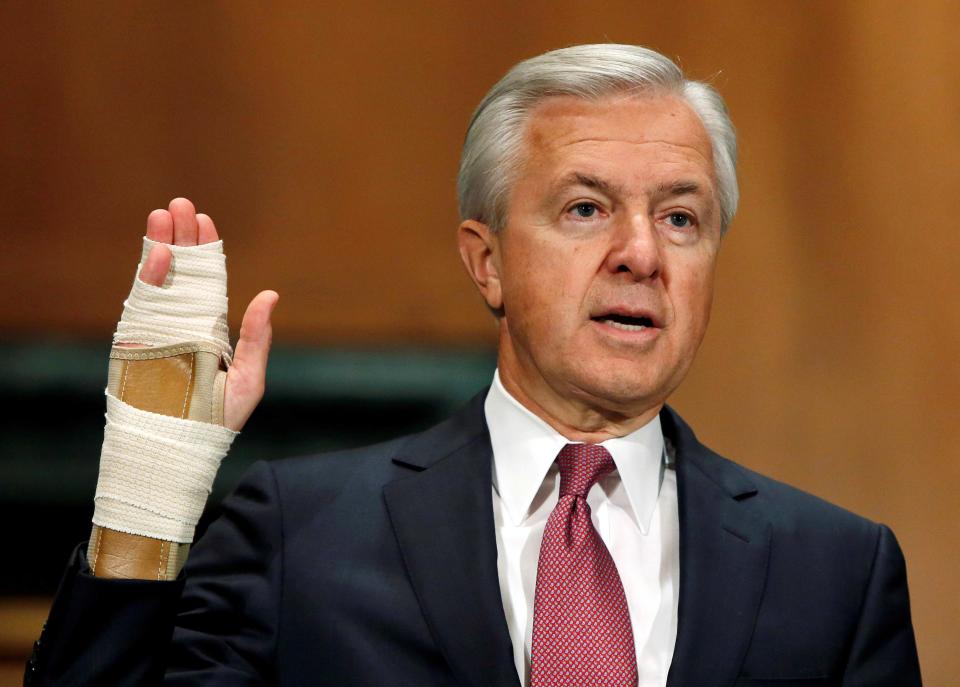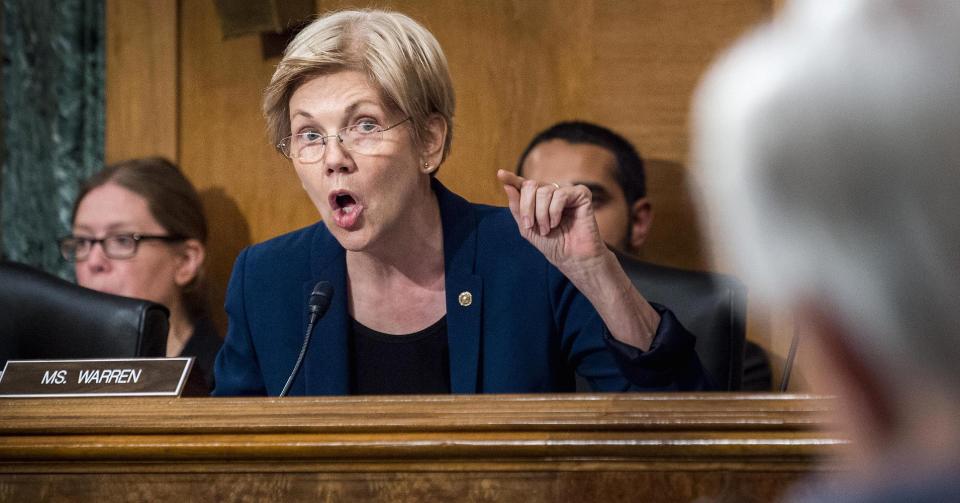Wells Fargo's scandals just won’t die

The thing about scandals in the Information Age is that they just won’t die. Look no further than Wells Fargo (WFC).
It’s almost a year after the bombshell announcement that Wells would pay $185 million to settle charges that it opened unauthorized accounts for customers, among other things. Now, there’s a new CFPB investigation and a wave of lawsuits over Wells’s mortgage practices. Last week, Elizabeth Warren sent a letter to the Federal Reserve with an unprecedented demand that the Fed seek the removal of Wells Fargo’s board of directors.
That’s not all. Lurking in the background is a largely forgotten lawsuit involving Wells’ overdraft practices. No wonder it’s been forgotten: The case has been tied up in torturous litigation for almost a decade. But the ultimate resolution could make the $185 million look like a small down payment for years of aggressive business practices.
Banks making big money off overdraft charges
Way back when, banks used to cover overdrafts without charging their customers. But starting in the early 1990s, banks began to figure out that this could be a rich source of fees. A 2008 FDIC report said that overdraft fees for debit cards could carry effective annualized interest rate exceeding 3500%.
And then banks figured out that overdraft charges could be even more lucrative if they were reordered. Instead of having them hit a customer’s account in the most straightforward way—chronologically—the banks could reorder them from largest to smallest in order to maximize the damage to their customers. So if you had $100 in your bank account, and you had a $5 cup of coffee, a $10 sandwich, a $50 gas bill, and a $175 grocery bill, in that order, you should pay one $35 overdraft fee. But if the bank reorders the charges to put the grocery bill first, they could collect three fees, or $105.

The practice of reordering charges was so widespread that a consulting company had even developed software that would help banks order the charges in the way that would yield the most profits, according to American Banker.
Of course, this hits those who can least afford it hardest. A 2016 study by the Pew Charitable Trusts noted that heavy over drafters—customers who pay more than $100 in overdraft fees in a year—generally have incomes below the US average, and overdraft fees could consume a significant portion of that. (Nor, as the date of the Pew study implies, is the overdraft issue dead. A December 2016 study by U.S. PIRG also found that such charges are again on the rise, this despite a 2010 Federal Reserve rule that was supposed to limit the ability to collect such fees by barring banks from charging them without having customers officially opt in. And a recent report in the Financial Times notes that Wells appears to be most aggressive of all: The bank has increased its income from overdraft charges “at more than five times the rate of its US bank peers.”)
‘The revenue generated from these fees has been massive’
By the late 2000s, lawsuits involving some three dozen banks, including Wells Fargo, JP Morgan and Bank of America, had cropped up around the country. In the case of Wells Fargo, plaintiffs alleged that the bank’s practices were contrary to its marketing materials, which said that debit card and ATM transactions “generally reduce the available balance in your account immediately” and that “purchase amounts are automatically deducted from your primary checking account.”
Most of the cases were consolidated under Judge Lawrence King in federal district court in Miami.
Around the same time, a separate class action, which was originally filed in California in 2007, involving the same issues went to trial. The suit alleged that “the revenue generated from these fees has been massive,” noting that in California alone, Wells Fargo assessed over $1.4 billion in overdraft penalties between 2005 and 2007. The complaint did not challenge the legitimacy of a single overdraft fee of $35. Rather, the essence of it was that “Wells Fargo has devised a bookkeeping device to turn what would ordinarily be one overdraft fee into as many as ten overdrafts.”
In the spring of 2008, Judge William Alsup ruled that Wells Fargo had “deliberately manipulated overdraft practices” to “profiteer” off its customers, and ordered the bank to refund $230 million to those who were charged for overdrafts between 2004 and 2008.
Wells appealed the decision twice on different grounds, and after losing those efforts, tried to get the Supreme Court to take it on. Finally, about a year ago—on April 4, 2016—and almost a decade after that lawsuit had been filed—the Supreme Court let the verdict stand. In its appeals, Wells argued there was no proof that the debit card users had ever read the bank’s written policies, so even if those policies were deceptive, that effectively didn’t matter. When the appeals court upheld the verdict, it said the California law protects consumers who have been hurt by a company’s deception, regardless of whether they read its disclosures.
As for the case in Miami, well, it is in legal hell. Initially, the banks all tried to get King to dismiss it. Among other things, the banks argued that the activities of national banks in conducting the “business of banking” are subject to exclusive federal regulation and so any state law “which attempts to regulate, limit, or condemn such activities” must be preempted. But in 2010, King denied the motion to dismiss.
Will Wells Fargo’s legal strategy backfire?
Over the next few years, most of the major banks settled the Miami litigation. In 2011, Bank of America agreed to pay $410 million, and the next year, JPMorgan agreed to pay $162 million. ($110 million of that was in cash, with the rest coming in the form of future savings for customers.)
Not Wells.
But that doesn’t mean that the case against Wells went to trial. Oh no. There were yet more legal maneuvers.

As the case wended its way through the system, King twice told the banks that if they wanted to try to force their customers into arbitration, they needed to choose that path, instead of litigating. But they couldn’t have it both ways. The banks chose to litigate, and lost the motion to dismiss.
But then, in 2011, in a case involving AT&T Mobility, the Supreme Court effectively made it easier for businesses to force customers into arbitration.
So at that point, Wells switched tactics and began to argue that despite King’s rulings, it could still force its customers into arbitration. In the intervening years, that argument has gone back and forth between the appeals court and King’s courtroom. King has consistently ruled that Wells lost its chance to compel arbitration when it decided to litigate.
Today, the core of Wells’s argument is that the judge’s ruling only applies to the named plaintiffs in the class action, not all the others, who could be forced into arbitration. Given the small dollar amount of the individual claims and the inability of those individual plaintiffs to afford lawyers, this is tantamount to making the case go away. (Not incidentally, forcing its customers to arbitrate even over accounts they didn’t sign up for in the first place is a tactic that Wells is using in the cases involving sham accounts.)
King disagrees. King’s argument, as he put it in a ruling last fall, is that “it would be unfair, and fundamentally at odds with the principles underlying the Federal Arbitration Act, to permit Wells Fargo to effectively ‘wait in the weeds’ and invoke arbitration, after years of litigation, now that the alternate path the bank chose did not turn out as it hoped.”
Wells, perhaps needless to say, is appealing this decision. Says the bank in a statement: “Wells Fargo continues to believe that arbitration is a fair, efficient and effective way for a customer to pursue a legal claim and resolve a legal dispute.”
Final briefs are due in August, at which point, the case will move one step closer to trial, over a decade after it began.
The financial ramifications for Wells could be large, given previous settlements. On the other hand, the ramifications for consumers should Wells win its bid to force them into arbitration are also big. A recent report by a nonprofit organization called Level Playing Field notes that given Wells’ size and the prevalence of reported problems, the bank “has experienced a shockingly low number of consumer arbitration cases”; the implication is that if the only choice is to arbitrate, consumers will often do nothing.
The irony, of course, is that but for a legal strategy that is as aggressive as its business strategy, Wells could have made this go away a long time ago. The question is whether the legal strategy will backfire in the same big way.
Bethany McLean is a contributing editor at Vanity Fair and bestselling author. Her recent book is “Shaky Ground: The Strange Saga of the U.S. Mortgage Giants,” published by Columbia Global Reports.
More from Bethany McLean:
